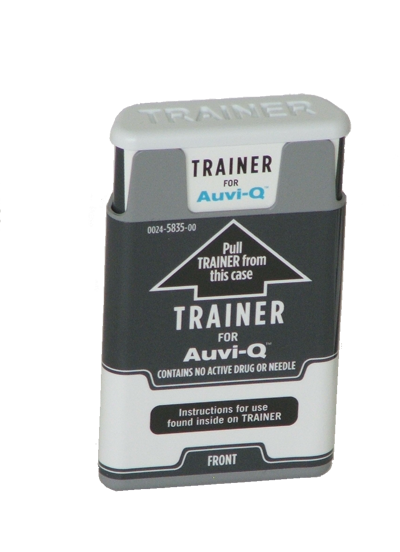Auvi-Q is an autoinjector that contains epinephrine (adrenalin) for the use in severe Type 1 allergic reactions – anaphylaxis.
Epinephrine is a non-selective alpha and beta-adrenergic receptor agonist. The results of an IM or SC injection are bronchodilation, vasoconstriction, and an increase in heart rate.
An acute, severe Type 1 allergic reaction, anaphylaxis, is caused by too great a release of histamines, via degranulation from the MAST cells, resulting in bronchoconstriction, vasodilation, and an itchy, urticarial rash. Thus, epinephrine is the perfect drug to counteract the effects of the histamines.
Remember, that you are taking advantage of the side effects of epinephrine in counteracting the potentially life-threatening effects of the histamines. But, the effects of epinephrine only last 20 – 30 minutes and then the acute allergic reaction can return.
The cure for the over-abundance of histamines is to give an antihistamine. So, remember that regardless of how the epinephrine is administered, it has to be followed with an oral antihistamine such as Benadryl (diphenhydramine) 50 mg by mouth every 4 hours for 24 hours (Benadryl 50mg po q4h x 24h).
What makes Auvi-Q unique is that it speaks to the individual administering the autoinjector. Designed to fit in a pant’s pocket so when needed it is readily accessible. The cap is removed, and the autoinjector will then talk you through the process of giving the shot.
You can go on their website, auvi-q.com, and watch a demonstration of its use.
It is impossible to accurately count the number of venomous snakebites worldwide, simply because most occur in rural and remote areas where access to medical care is limited, statistics are not kept, and snakebites are not reported.
Worldwide:
There are reportedly 421,000 envenomations per year with 20,000 deaths.
But, snakebites and deaths from snakebites are grossly underreported.
It is estimated that the real numbers could be as high as 1,841,000 envenomations with 94,000 deaths per year.
United States:
Approximately 8000 venomous snakebites are reported each year with 5 – 10 deaths per year.
SNAKES ARE:
–elongated
–legless/limbless
–carnivorous reptiles
–lack eyelids
–lack external ears
–ectothermic (cold-blooded)
–most are amniote vertebrates (lay eggs that contain amniotic fluid, suitable for the terrestrial environment), some snakes do have live births
–covered in overlapping scales
–most kill by swallowing their prey whole or death by constriction
–of the 3,400 species, 300 are venomous and use their venom to kill, subdue, and digest their prey
Kingdom – Animalia
Phylum – Chordata
Class – Reptilia
Order – Squamata
Suborder – Serpentes
Family – 20 different families
4 families are venomous
Genera – 500 different Genera
Species – 3,400 different species
3,100 are nonvenomous
300 are venomous
Interestingly enough, venomous snakes can be divided into different families based on their dentition and types of fangs, not as you might suspect, by the type of venom they possess. The rest of snakes are fangless, aglyphous.
https://www.wildernessmedicinenewsletter.com/wp-content/uploads/2014/10/wmnlogo20151.png00WMN Editorshttps://www.wildernessmedicinenewsletter.com/wp-content/uploads/2014/10/wmnlogo20151.pngWMN Editors2013-08-22 19:55:542013-12-02 13:47:18THE WORLD OF VENOMOUS SNAKES
HIV continues to be one of the most important infectious diseases that we have to contend with around the world. Even though it is under better control and there exists improved treatment modalities, it still remains a very important source of mortality and morbidity in both the developed nations and the developing nations.
This article is a concise review and primer of HIV, an update of the treatment modalities currently available in the fight against HIV, and a simple reminder of the remarkable negative influence that it still has around the world.
What is HIV?
HIV is short for Human Immunodeficiency Virus. It is a RNA retrovirus that invades and destroys the T Helper cells of our immune system. This destruction of the T helper cells causes a progressive failure of the immune system, leading to susceptibility to opportunistic infections and generally death secondary to these opportunistic infections. Opportunistic infections are infections that would not normally be able to overcome our immune defenses.
https://www.wildernessmedicinenewsletter.com/wp-content/uploads/2014/10/wmnlogo20151.png00WMN Editorshttps://www.wildernessmedicinenewsletter.com/wp-content/uploads/2014/10/wmnlogo20151.pngWMN Editors2013-05-28 14:26:092013-08-22 20:06:25HUMAN IMMUNODEFICIENCY VIRUS 2013 HIV Primer and Update
There are quite a few foods that we commonly eat that contain potentially lethal toxins. Fortunately, they are in trace quantities, and our liver is generally able to detoxify them before they can cause us any harm.
One particular toxin that is found in a variety of foods is amygdalin, a cyanogenic glycoside that is metabolized into hydrogen cyanide (HCN). Egads! CYANIDE– that could kill you!
Cyanide can be found in the following seeds and foods:
Apple seeds Cherry pits
Peach pits Apricot pits
Plums Pears
Almonds Lima beans
Nectarines Barley
Cabbage Sorghum
Broccoli Cauliflower
Flaxseed Bamboo
White Clover
Cassava root = tapioca, manioc, yuca
The questions are where does the cyanide come from, and why it is in these seeds, fruits, or vegetables?
Some plants have the ability to fix nitrogen to carbon with a triple bond, making hydrogen cyanide = HCN, one hydrogen atom, one carbon atom, and one nitrogen atom. Of course at this point, you’re wondering why aren’t all plants potentially cyanide carriers.The plants have to have the enzymes necessary to carry out these chemical reactions and it has to be able to store the hydrogen cyanide without harming itself.
https://www.wildernessmedicinenewsletter.com/wp-content/uploads/2014/10/wmnlogo20151.png00WMN Editorshttps://www.wildernessmedicinenewsletter.com/wp-content/uploads/2014/10/wmnlogo20151.pngWMN Editors2013-05-28 14:25:542013-05-28 14:25:54TOXINS IN THE FOODS WE EAT and CYANIDE
AUVI-Q
/in Allergies, Medications/by WMN EditorsISSN-1059-6518 Volume 26 Number 3
A NEW PRODUCT FOR TREATING ANAPHYLAXIS
AUVI-Q
By Frank Hubbell, D.O.
INDICATIONS:
Auvi-Q is an autoinjector that contains epinephrine (adrenalin) for the use in severe Type 1 allergic reactions – anaphylaxis.
Epinephrine is a non-selective alpha and beta-adrenergic receptor agonist. The results of an IM or SC injection are bronchodilation, vasoconstriction, and an increase in heart rate.
An acute, severe Type 1 allergic reaction, anaphylaxis, is caused by too great a release of histamines, via degranulation from the MAST cells, resulting in bronchoconstriction, vasodilation, and an itchy, urticarial rash. Thus, epinephrine is the perfect drug to counteract the effects of the histamines.
Remember, that you are taking advantage of the side effects of epinephrine in counteracting the potentially life-threatening effects of the histamines. But, the effects of epinephrine only last 20 – 30 minutes and then the acute allergic reaction can return.
The cure for the over-abundance of histamines is to give an antihistamine. So, remember that regardless of how the epinephrine is administered, it has to be followed with an oral antihistamine such as Benadryl (diphenhydramine) 50 mg by mouth every 4 hours for 24 hours (Benadryl 50mg po q4h x 24h).
What makes Auvi-Q unique is that it speaks to the individual administering the autoinjector. Designed to fit in a pant’s pocket so when needed it is readily accessible. The cap is removed, and the autoinjector will then talk you through the process of giving the shot.
You can go on their website, auvi-q.com, and watch a demonstration of its use.
DOSAGE FORMS AND STRENGTHS:
Adult: greater than or equal to 30kg (66lbs)
0.3mg: 0.3mg/0.3ml of 1/1000 epinephrine.
Pediatric: 15 – 30kg (33 – 66lbs)
0.15mg: 0.15mg.0.15ml of 1/1000 epinephrine.
Contraindications:
NONE
WARNINGS AND PRECAUTIONS:
Read more
THE WORLD OF VENOMOUS SNAKES
/in Bites and Stings, Neurological, Poisons, Respiratory System/by WMN EditorsISSN-1059-6518
THE WORLD OF VENOMOUS SNAKES
By Frank Hubbell, D.O.
SNAKE BITE STATISTICS:
It is impossible to accurately count the number of venomous snakebites worldwide, simply because most occur in rural and remote areas where access to medical care is limited, statistics are not kept, and snakebites are not reported.
Worldwide:
There are reportedly 421,000 envenomations per year with 20,000 deaths.
But, snakebites and deaths from snakebites are grossly underreported.
It is estimated that the real numbers could be as high as 1,841,000 envenomations with 94,000 deaths per year.
United States:
Approximately 8000 venomous snakebites are reported each year with 5 – 10 deaths per year.
SNAKES ARE:
– elongated
– legless/limbless
– carnivorous reptiles
– lack eyelids
– lack external ears
– ectothermic (cold-blooded)
– most are amniote vertebrates (lay eggs that contain amniotic fluid, suitable for the terrestrial environment), some snakes do have live births
– covered in overlapping scales
– most kill by swallowing their prey whole or death by constriction
– of the 3,400 species, 300 are venomous and use their venom to kill, subdue, and digest their prey
Kingdom – Animalia
Phylum – Chordata
Class – Reptilia
Order – Squamata
Suborder – Serpentes
Family – 20 different families
4 families are venomous
Genera – 500 different Genera
Species – 3,400 different species
3,100 are nonvenomous
300 are venomous
Interestingly enough, venomous snakes can be divided into different families based on their dentition and types of fangs, not as you might suspect, by the type of venom they possess. The rest of snakes are fangless, aglyphous.
Read more
HUMAN IMMUNODEFICIENCY VIRUS 2013 HIV Primer and Update
/in HIV, Specific Disease/by WMN EditorsISSN-1059-6518
Volume 26 Number 2
By Frank Hubbell, DO
HIV continues to be one of the most important infectious diseases that we have to contend with around the world. Even though it is under better control and there exists improved treatment modalities, it still remains a very important source of mortality and morbidity in both the developed nations and the developing nations.
This article is a concise review and primer of HIV, an update of the treatment modalities currently available in the fight against HIV, and a simple reminder of the remarkable negative influence that it still has around the world.
What is HIV?
HIV is short for Human Immunodeficiency Virus. It is a RNA retrovirus that invades and destroys the T Helper cells of our immune system. This destruction of the T helper cells causes a progressive failure of the immune system, leading to susceptibility to opportunistic infections and generally death secondary to these opportunistic infections. Opportunistic infections are infections that would not normally be able to overcome our immune defenses.
Read more
TOXINS IN THE FOODS WE EAT and CYANIDE
/in Nausea, Poisons, Respiratory System, Shortness of breath/by WMN EditorsVolume 26 Number 2
ISSN-1059-6518
By Frank Hubbell, DO
There are quite a few foods that we commonly eat that contain potentially lethal toxins. Fortunately, they are in trace quantities, and our liver is generally able to detoxify them before they can cause us any harm.
One particular toxin that is found in a variety of foods is amygdalin, a cyanogenic glycoside that is metabolized into hydrogen cyanide (HCN). Egads! CYANIDE– that could kill you!
Cyanide can be found in the following seeds and foods:
Apple seeds Cherry pits
Peach pits Apricot pits
Plums Pears
Almonds Lima beans
Nectarines Barley
Cabbage Sorghum
Broccoli Cauliflower
Flaxseed Bamboo
White Clover
Cassava root = tapioca, manioc, yuca
The questions are where does the cyanide come from, and why it is in these seeds, fruits, or vegetables?
Some plants have the ability to fix nitrogen to carbon with a triple bond, making hydrogen cyanide = HCN, one hydrogen atom, one carbon atom, and one nitrogen atom. Of course at this point, you’re wondering why aren’t all plants potentially cyanide carriers. The plants have to have the enzymes necessary to carry out these chemical reactions and it has to be able to store the hydrogen cyanide without harming itself.
Read more